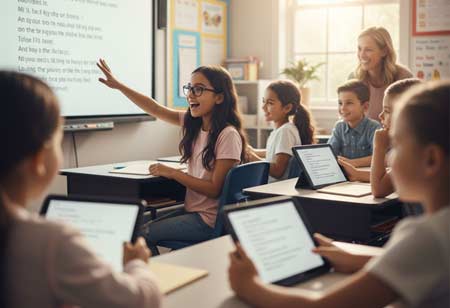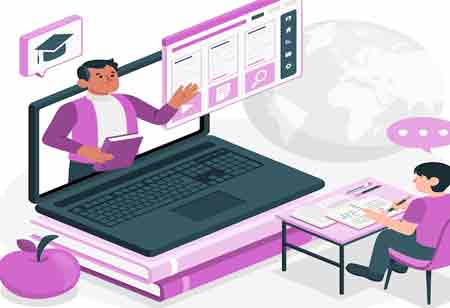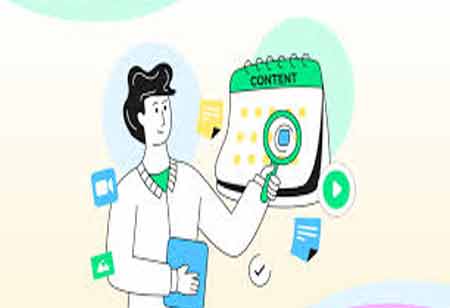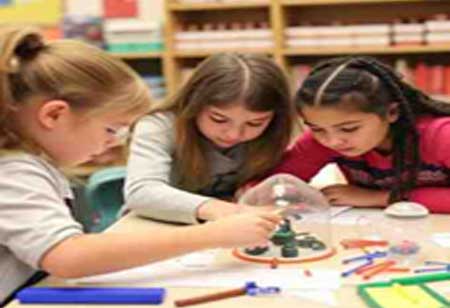THANK YOU FOR SUBSCRIBING
Be first to read the latest tech news, Industry Leader's Insights, and CIO interviews of medium and large enterprises exclusively from Education Technology Insights
Embracing Innovation: The Latest Trends in Education Technology
Student involvement has become apparent as a critical component of academic performance and overall learning outcomes in the ever-changing educational landscape.

By
Education Technology Insights | Monday, June 26, 2023
Stay ahead of the industry with exclusive feature stories on the top companies, expert insights and the latest news delivered straight to your inbox. Subscribe today.
Educational technology has embraced the latest trends in educational technology, transforming the learning process and equipping teachers with resources.
FREMONT, CA: Student involvement has become apparent as a critical component of academic performance and overall learning outcomes in the ever-changing educational landscape. Innovative techniques that place a higher priority on active involvement and personalised learning opportunities are challenging traditional educational paradigms that emphasise passive learning and one-size-fits-all methods. Several initiatives have evolved in recent years to improve student engagement and develop dynamic learning settings that respond to the requirements and interests of individual students.
The trends in Education Technology to have a better understanding.
1. Learning Collectively
Collaborative learning is important for student engagement, as it encourages active participation, social interaction, diversity of perspectives, enhanced understanding, peer-to-peer teaching, and skill development. Active participation encourages higher levels of engagement compared to passive learning methods. Social interaction fosters communication, cooperation, and the development of interpersonal skills. Diverse perspectives enrich the learning environment by exposing students to different ways of thinking and problem-solving. Learning collectively promotes student engagement by fostering active participation, social interaction, diverse perspectives, enhanced understanding, skill development, increased motivation, and peer support. This creates a dynamic and interactive learning environment that can have a positive impact on students' overall learning experience and academic outcomes.
2. Learning with Social Media Platforms
Social media platforms can significantly enhance student engagement by providing access to educational content, collaborative learning opportunities, active learning and participation, multimedia and visual learning, and the use of multimedia and visual content. Accessibility and convenience, collaborative learning opportunities, active learning and participation, multimedia and visual learning, and the use of multimedia and visual content all contribute to student engagement. Social media platforms offer numerous benefits for student engagement, such as informal learning spaces, personalized learning opportunities, and real-world connections. However, careful guidance and supervision are necessary to ensure a safe and focused learning environment. Educators and institutions should establish guidelines, provide resources, and monitor online interactions to maximize the positive impact of social media on student engagement.
3. Interactivity in Classroom
Classroom interactivity can promote student engagement by encouraging discussion-based activities, questioning techniques, group work and collaboration, and technology integration. Discussion-based activities encourage critical thinking, questioning techniques encourage collaboration, group work and collaboration enhance social interaction, communication skills, and teamwork, and technology integration makes learning more engaging and personalized. Hands-on Experiences, Gamification, Formative Assessment, Differentiation, Real-World Connections, and a Positive Classroom Environment are key to increasing engagement in the classroom. Hands-on activities, experiments, and real-world applications promote deeper understanding and engagement. Gamified activities make learning fun, competitive, and interactive.
Formative Assessment encourages active participation and tracking progress. Differentiation recognizes and accommodates diverse learning styles. Real-World Connections make learning relevant and applicable to students' experiences.
4. Analytical Data Management
Analytical data management can play a significant role in enhancing student engagement. By collecting and analysing data related to student performance, behaviour, and participation, educators can gain valuable insights that inform their instructional practices and support personalized learning experiences. It's important to ensure that student data is handled securely and in compliance with privacy regulations. Additionally, educators should use data as a tool to inform their instructional practices rather than relying solely on data-driven decisions. A balanced approach that considers the whole student and their unique needs is crucial for effective student engagement.
5. Holistic Augmented Reality and Virtual Reality Learning
Holistic AR and VR learning can significantly enhance student engagement by providing immersive and interactive educational experiences. These include Immersive Experiences, Interactive Simulations, Personalised Learning, and Collaborative Learning. Immersive Experiences involve transporting students to virtual worlds or overlaying digital information onto the real world, while Interactive Simulations enable students to practice skills and experiment with concepts in a safe and controlled environment. Personalised Learning tailors content, difficulty levels, and learning paths accordingly, while Collaborative Learning facilitates collaborative learning experiences in remote or distributed environments. AR and VR technologies can foster engagement by enabling group projects, discussions, and teamwork.
Gamification elements can make the educational experience more enjoyable and motivating. Real-world connections can bridge the gap between classroom learning and real-world applications. Multisensory engagement can enhance information processing and retention. Educators should receive appropriate training to effectively implement these technologies and provide access to necessary hardware and software infrastructure.
8. Individualised Learning
Individualized learning is a key factor in enhancing student engagement by tailoring educational experiences to meet each student's unique needs, interests, and learning styles. It includes personalised learning paths, adaptive learning systems, learning styles and preferences, goal setting and progress monitoring, choice and autonomy, and self-assessment tools. These strategies help students feel connected, motivated, and empowered in their education. Individualized learning can offer options such as selecting topics for projects, choosing from a range of assignments, or deciding how to present knowledge. It can also incorporate students' interests and real-life connections into the curriculum, provide timely and constructive feedback, and foster collaboration and peer support. Implementing individualised learning requires educators to have a deep understanding of their students, strong instructional design skills, and access to appropriate technology and resources.
Student engagement is a crucial factor in effective education, and individualized learning and the integration of immersive technologies like Augmented Reality (AR) and Virtual Reality (VR) play significant roles in enhancing student engagement. By personalizing learning paths, accommodating diverse learning styles, and incorporating students' interests and preferences, individualised learning empowers students, fostering their motivation and ownership of the learning process. Additionally, the use of AR and VR technologies provides immersive and interactive experiences that captivate students' attention, making learning more engaging, memorable, and relevant. By embracing these approaches, educators can create dynamic and inclusive learning environments that promote active participation, collaboration, and a lifelong love for learning.







